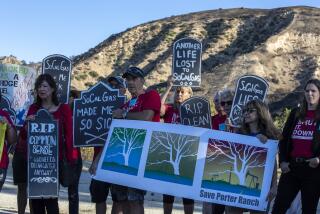SoCal Gas Raises Reserves; Firms’ Service Restored : Six Electric Utilities Still Using Fuel Oil as Allotments Are Curtailed
- Share via
Southern California Gas Co., declaring that it has replenished its natural-gas storage reservoirs to adequate levels, said it restored service Monday to more than 800 industrial customers that had been cut off Jan. 4 because of a gas shortage.
The gas company said it continues to curtail most deliveries to its biggest customers, six electric utilities in the region. Those utilities have been forced to use fuel oil instead of natural gas to power their boilers since Dec. 17.
SoCal Gas, the nation’s largest gas utility, restricted its shipments of natural gas after cold weather in Southern California boosted demand to record levels while problems elsewhere in the country limited the amount of gas it could bring into the state daily in December.
The rise in demand and shortfall in receipts of gas forced the utility to draw more heavily than expected on its underground storage reservoirs, which the company hadn’t filled to the targeted level at the onset of winter.
By Monday, SoCal Gas said it had 37 billion cubic feet in storage. With normal usage it will have 30 bcf underground at the end of January versus a pre-winter target of 25 bcf by that date, a spokesman said.
Triggered by Drop in Storage
The cutoff of service to about 850 commercial customers was triggered by a drop in the storage level to just 34 bcf on Jan. 1, compared to a desired 50 bcf for that date.
The amount of gas held in the utility’s six underground reservoirs is scheduled to decline over the course of the winter, but can vary daily according to how much purchased gas enters SoCal’s system and how much the company has to send to customers.
The utility said it has been able to slightly increase the amount of gas in storage because the cutoff of deliveries meant it sent out about 900 million cubic feet per day less than before. Meanwhile, the two pipelines serving the region were able to deliver a full complement of gas during the period.
The cutoff of gas deliveries was limited to customers with backup fuel systems, most of which use fuel oil. However, it was the first time since the late 1970s that such curtailments had extended beyond the electric utilities, which can switch most readily to other fuels.
The backup fuel systems are intended to ensure that natural gas to residences won’t be interrupted. However, the episode will ultimately drive residential bills higher if the utility is allowed to pass on the higher costs that the delivery cutoffs entailed.
SoCal Gas is paying a premium for natural gas to replenish its storage reservoirs, compared to prices available last summer. Meanwhile, the curtailment means the utility sold about 10 billion fewer cubic feet of gas since Dec. 17 than it would have otherwise.
It will be up to the California Public Utilities Commission to decide whether SoCal Gas can make up those costs later through higher rates for customers. A gas company spokesman said it is “far too early” to estimate the added costs.
Michael Florio, an attorney for the consumer group Toward Utility Rate Normalization in San Francisco, said the failure to sell about 10 bcf might cost SoCal Gas “on the order of magnitude of $5 million to $15 million,” a minor sum for the huge utility.
“The big question is why their storage wasn’t full for the winter,” Florio said. “If it was preventable, it would be appropriate for them to be assessed a penalty for the money they didn’t make” because they had to curtail services, he said.
Current gas bills will be sharply higher in any case because of the higher usage during the cold weather and the higher rates which take effect at those levels.
Meanwhile, SoCal Gas said it has halted the emergency purchase of about 300 million cubic feet of gas per day from Pacific Gas & Electric in San Francisco. The purchases began this month under a mutual-assistance pact triggered for the first time since it was created in 1979.
The affected electric-generating companies are Southern California Edison, Los Angeles Department of Water and Power, Imperial Irrigation District and the municipal utilities in Pasadena, Burbank and Glendale.
Natural gas has been cheaper than oil in recent years and is preferred by the electric utilities and environmental regulators because it burns more cleanly. When forced to burn oil, the utilities use special low-sulfur oil for environmental reasons.
But the air quality penalties of burning fuel oil have been mitigated by the strong winds and cold weather in the past several weeks, said Herman Huettemeyer, manager of fuel at Edison.
“We are complying with the air quality regulations even though we’re burning oil,” said Huettemeyer. “If that changed to a Santa Ana condition, it would be a real nuisance.”
He added that as the price of natural gas surged and the price of oil subsided in recent months, the disparity between the two has almost vanished so that there has been “no significant financial penalty” to using oil instead of gas.
More to Read
Sign up for Essential California
The most important California stories and recommendations in your inbox every morning.
You may occasionally receive promotional content from the Los Angeles Times.













